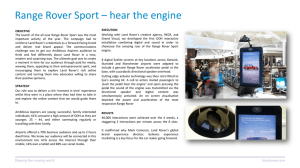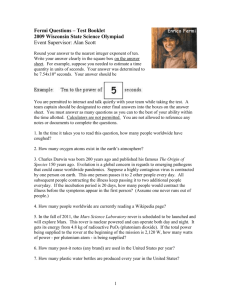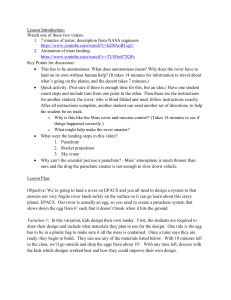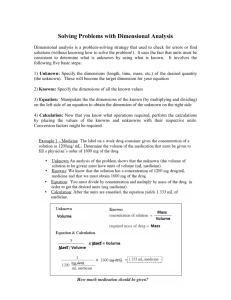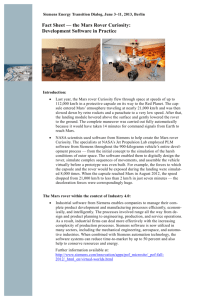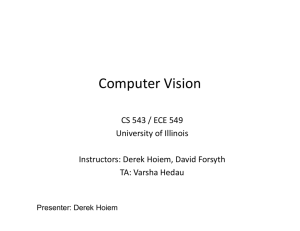The Rescue of Rover (2): Bargaining under TUPE
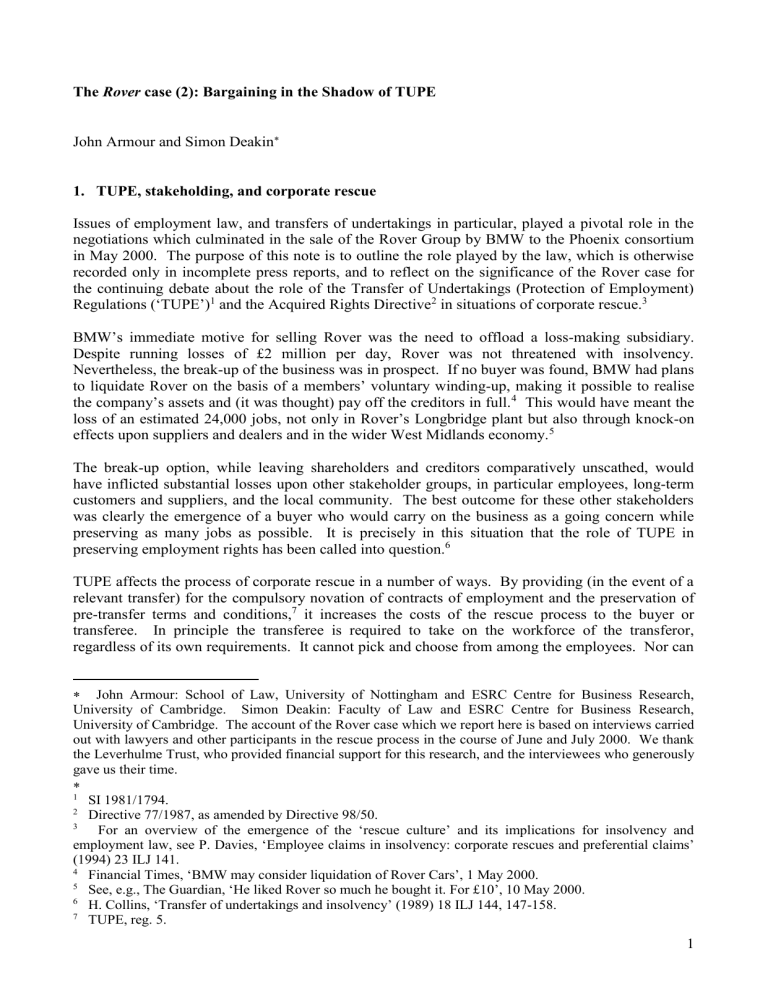
The Rover case (2): Bargaining in the Shadow of TUPE
John Armour and Simon Deakin
1.
TUPE, stakeholding, and corporate rescue
Issues of employment law, and transfers of undertakings in particular, played a pivotal role in the negotiations which culminated in the sale of the Rover Group by BMW to the Phoenix consortium in May 2000. The purpose of this note is to outline the role played by the law, which is otherwise recorded only in incomplete press reports, and to reflect on the significance of the Rover case for the continuing debate about the role of the Transfer of Undertakings (Protection of Employment)
Regulations (‘TUPE’) 1
and the Acquired Rights Directive
2
in situations of corporate rescue.
3
BMW’s immediate motive for selling Rover was the need to offload a loss-making subsidiary.
Despite running losses of £2 million per day, Rover was not threatened with insolvency.
Nevertheless, the break-up of the business was in prospect. If no buyer was found, BMW had plans to liquidate Rover on the basis of a members’ voluntary winding-up, making it possible to realise the company’s assets and (it was thought) pay off the creditors in full.
4
This would have meant the loss of an estimated 24,000 jobs, not only in Rover’s Longbridge plant but also through knock-on effects upon suppliers and dealers and in the wider West Midlands economy.
5
The break-up option, while leaving shareholders and creditors comparatively unscathed, would have inflicted substantial losses upon other stakeholder groups, in particular employees, long-term customers and suppliers, and the local community. The best outcome for these other stakeholders was clearly the emergence of a buyer who would carry on the business as a going concern while preserving as many jobs as possible. It is precisely in this situation that the role of TUPE in preserving employment rights has been called into question.
6
TUPE affects the process of corporate rescue in a number of ways. By providing (in the event of a relevant transfer) for the compulsory novation of contracts of employment and the preservation of pre-transfer terms and conditions,
7
it increases the costs of the rescue process to the buyer or transferee. In principle the transferee is required to take on the workforce of the transferor, regardless of its own requirements. It cannot pick and choose from among the employees. Nor can
John Armour: School of Law, University of Nottingham and ESRC Centre for Business Research,
University of Cambridge. Simon Deakin: Faculty of Law and ESRC Centre for Business Research,
University of Cambridge. The account of the Rover case which we report here is based on interviews carried out with lawyers and other participants in the rescue process in the course of June and July 2000. We thank the Leverhulme Trust, who provided financial support for this research, and the interviewees who generously gave us their time.
1 SI 1981/1794.
2 Directive 77/1987, as amended by Directive 98/50.
3 For an overview of the emergence of the ‘rescue culture’ and its implications for insolvency and employment law, see P. Davies, ‘Employee claims in insolvency: corporate rescues and preferential claims’
(1994) 23 ILJ 141.
4 Financial Times, ‘BMW may consider liquidation of Rover Cars’, 1 May 2000.
5 See, e.g., The Guardian, ‘He liked Rover so much he bought it. For £10’, 10 May 2000.
6 H. Collins, ‘Transfer of undertakings and insolvency’ (1989) 18 ILJ 144, 147-158.
7 TUPE, reg. 5.
1
it easily renegotiate their terms and conditions post-transfer to make them more compatible with those of its other employees. If it dismisses transferred employees which it does not need, it will be required to pay redundancy compensation taking account not just of their accrued seniority with the transferor, but also of any contractual rights which they may have carried over from their previous employment.
In principle these liabilities, while substantial, can be overcome through bargaining between the transferor and the transferee. It is no longer possible, following the Litster decision,
8
for the transferee to procure the dismissal of the transferor’s workforce prior to the sale in order to avoid
TUPE altogether. However, it is open to the transferee to negotiate a reduction in the sale price as a quid pro quo for the liabilities which it will incur under TUPE. But this gives rise to a further set of problems. Those employees who lose their jobs as a result of the transfer will now be paid off in full, whereas, prior to Litster , they would have been confined to a claim against the state which would only have covered their statutory redundancy compensation or the basic award in unfair dismissal (assuming that they were unable to recover these amounts from the insolvent transferor), and not the compensatory award. This is a good outcome for the employees, but arguably unfair to other creditors, since the income made available to them from the sale of the insolvent business is reduced by the amount which the transferee has deducted from the sale price in order to comply with TUPE. This is the basis for the idea that Litster confers a kind of ‘super-priority’ on the employees.
The negative effects of the employees’ super-priority can however be exaggerated. It is not much of an argument to say that it offends the normal priority of claims in insolvency, since it is simply one of a long list of exceptions carved out from the pari passu principle that creditors should recover equally from the insolvent company’s assets in proportion to the size of their claim.
9
Banks normally avoid pari passu by taking a floating charge over the company’s assets which enables them to appoint a receiver in the event of default and recover their losses in advance of the unsecured creditors. Trade creditors can attempt to ring-fence goods which they have supplied from the insolvency process, through retention of title clauses. Unlike banks or trade suppliers, employees virtually never contract for extra protection in this way. It is possible that this is because of the high transaction costs of such bargaining, in which case TUPE may be seen as supplying a statutory solution.
10
A more worrying objection is that TUPE can deter the transferee from making the acquisition in the first place. Again, an economic analysis is useful here. If the various parties concerned had perfect information, the transferee could always negotiate a discount to the price in order to reflect its
TUPE liabilities. If these TUPE liabilities were greater than the price the transferee would otherwise be prepared to pay, then the deal will not go ahead. This seems to go against the policy of the law in seeking to facilitate corporate rescue.
11
The efficiency arguments for and against Litster are arguably quite finely balanced. The key to understanding the implications of that decision lies in considering its effects upon both pre- and post-transfer bargaining between the various parties – above all the creditors and employees of the failing business and the managers of both the companies concerned. Litster closes off one form of bargaining solution – the pre-transfer dismissal of the employees, aimed at avoiding TUPE
8 Litster v. Forth Dry Dock & Engineering Co.
[1989] IRLR 161.
9 See eg R. Goode, Principles of Corporate Insolvency Law , 2nd ed (London: Sweet & Maxwell), 143-144.
10 See K. Stone, ‘Policing employment contracts within the nexus-of-contracts firm’ (1993) 43 U. Toronto
L.J. 353.
11 Collins, op. cit.; S. Frisby, ‘TUPE or not TUPE? Employee protection, corporate rescue, and one unholy mess’ forthcoming (2000) 4 CFILR.
2
altogether – but leaves others open. These are not limited to the case we have just been considering, namely the variation of the sale price. A number of other, dynamic bargaining effects are possible once the employees themselves become active participants in the negotiation process.
In this respect, it is a less salient feature of TUPE which plays the crucial role: the collective information and consultation rights which the law vests in employee representatives in the event of transfers.
12 These statutory guarantees provide a basis for the exercise of employee voice which makes it possible for their interests, as stakeholders, to be factored into the bargaining process which takes place around corporate rescues. The redundancy consultation law
13
works in tandem with the transfer requirements; since transfers are often attended by large-scale job losses, the employee representatives can assert the right to bring the employers to the bargaining table well in advance of, or after, the actual transfer. Both types of consultation law have potentially become much more effective after the strengthening, from the mid-1990s, of the remedies associated with the protective award.
14
In cases where many employees are covered by a protective award, liabilities can run into tens or hundreds of millions of pounds.
For a bargaining solution to be possible to the problems posed by corporate rescue, however, the employee representatives would have to be in a position to use employment rights not as an absolute goal, but as a basis for negotiation – and perhaps to negotiate part of them away.
Negotiation of just this kind is envisaged by Article 4a of the amended Acquired Rights Directive, introduced in 1998.
15
However, it is far from clear how far such negotiation could work in practice.
In this respect, the Rover case is a highly informative example of the law currently works, and might work in future.
2.
The role of employment law in the sale of Rover
Negotiations for the sale of Rover to Alchemy Partners, a London-based venture capital firm, began in secret in October 1999, and were only made public in March 2000 when BMW announced its intention to sell the Rover and MG brands to Alchemy together with the Longbridge plant. BMW indicated its intention to retain the Cowley plant for the production of the new Mini model, and shortly after announced that it would be selling the profitable Land Rover division to Ford. It soon became clear that Alchemy intended significantly to reduce the scale of production at Longbridge, by focusing on the small niche market for MG cars at the expense of the Rover brands. On this basis, its bid received a hostile reception from the trade unions and a frosty one from local authorities in the west midlands. In late March a rival bid, which became the Phoenix consortium, was announced. This was led in due course by John Towers, a former chief executive of Rover, and was premised on retaining Longbridge as volume car production facility. However, for most of the month of April, BMW refused to enter into negotiations with Phoenix, and continued instead to move towards finalising the sale of Rover to Alchemy.
12 TUPE, regs. 10-11A.
13 TULRCA 1992, ss. 188 et seq.
14 In particular, until the amendments made to TUPE and TULRCA in response to the judgment of the ECJ in Cases C-382/92 and C-383/92 Commission v. UK [1994] IRLR 392, 412, the protective award was set off against employees’ wages for the period in question, greatly reducing its effectiveness as a deterrent against employer breach.
15 Directive 98/50.
3
When the sale to Alchemy was pending, six new business units were formed as subsidiary companies of the Rover Group. The shares in these companies were then purchased by BMW’s UK holding company. The purpose was to separate out those parts of the group which would stay with
BMW (such as the engine plant and the Cowley works which was to be retained to produce the new
Mini model for BMW), those which would be sold to Ford (Land Rover), and those parts which would be left for Alchemy. The effect was to create seven subsidiaries in all, including the original
Rover Group company from which the other six had been spun off. The intention was to effect the sale of the Longbridge assets to Alchemy in the form of a transfer of shares in the residual Rover
Group company.
16
Since the sale of Rover would only involve a transfer of shares and not a formal change of employer, BMW and Alchemy could argue that TUPE did not apply. If this was the case employees would retain whatever statutory and contractual rights they had when Alchemy took over, but there would no duty to consult or inform in respect of the takeover. Nor would Alchemy be rigidly bound to preserve terms and conditions after the transfer under the terms of regulation 5 of TUPE and the Wilson decision.
17
However, it was more clearly arguable that transfers had taken place in the case of the creation of the six new subsidiary companies, to which employees within the relevant business units had been allocated. This was because it was akin to a process of hiving down of the type which, under case law, could be regarded as a single transaction, in which BMW’s UK holding company was substituted for Rover as the employer. The unwillingness of the courts to accept that TUPE could be avoided by complex transactions of this type was reasserted in the recent decision of the High
Court In the Matter of Maxwell Fleet and Facilities Management Ltd .
18
Lawyers acting for a group of managerial employees advanced the argument that the creation of the ‘residual’ Rover company, in anticipation of the sale of shares to Alchemy, was also akin to a hiving down and, as such, would in due course be caught by TUPE. This point was less clearly in the employees’ favour, but it could not be said to have been beyond doubt.
Diagram 1: Structure of the proposed sale transaction
BMW AG
BMW (UK)
Holdings Ltd shares
2
Rover Group
Ltd assets
1
Subsidiaries containing assets not being sold to Alchemy
3
16 See diagram 1.
17 Wilson v. St. Helens DC [1999] 4 All ER 609.
18 [2000] IRLR 368, 372-373.
4
1
Assets not being sold to Alchemy hived down from
Alchemy
Rover Group to six newly formed subsidiaries.
Partners
2
Shares in the six subsidiaries transferred from Rover Group to BMW (UK). shares
3
Shares in ‘rump’ of Rover Group transferred from BMW (UK) to Alchemy Partners.
Neither Rover Group nor any of BMW’s other UK subsidiaries had entered into consultation with employee representatives over the transfers. The relevant employee representatives were the recognised unions, which thereby had the opportunity to initiate litigation directly. It was also argued by the employees that since both BMW and Alchemy had indicated that there would be redundancies arising from the sale of Rover Group and the other subsidiary companies, a breach of the redundancy consultation laws had occurred. In Kerry Foods Ltd.
v. Kreber ,
19
the EAT held that an employer’s liability under a protective award could be transferred over under regulation 5 of
TUPE, overruling earlier case law. This meant that any failure by BMW or its subsidiaries to comply with the information and consultation requirements would be transmitted to buyers of its businesses. The ECJ’s decision in Allen v. Amalgamated Construction Co. Ltd.
20 confirmed that there was no reason why transfers of undertakings between companies in the same corporate group could not come under the Acquired Rights Directive, thereby further strengthening the employees’ claims. On these various bases, the unions lodged applications for protective awards covering all
28,000 employees of the former Rover Group before employment tribunals at the end of April. In addition, steps were taken to prepare individual claims in respect of breach of contract for dismissals carried out in contravention of ‘no compulsory redundancy’ agreements entered into between Rover and the unions, which, it was claimed, had been incorporated into employees’ contracts of employment. Altogether, the potential value of these claims exceeded £300 million.
It was against this background that Alchemy withdrew from negotiations with BMW on 27 April, only a day or so from the deadline set for finalising the deal. The catalyst for this turn of events was
BMW’s insistence that Alchemy should offer it an indemnity against potential claims for (among other things) breach of the information and consultation laws, and contractual claims for wrongful dismissal. It was reported that Alchemy had been ready to pay £50 million for the company, with
BMW meeting certain liabilities arising from restructuring, but that it was not prepared to agree to an indemnity extending to ‘hundred and hundreds of millions of pounds.’
21
The sale to the Phoenix consortium was completed on 10 May. Rover was sold for a nominal £10, with BMW putting in £575 million to help meet short-term running costs. The Phoenix management pressed the unions to agree to a waiver of claims arising out of the failure of BMW
(through Rover) to begin consultation at the time the prospective sale to Alchemy was announced.
Although the claim was not waived, agreement was reached on its withdrawal on the basis that consultation between Phoenix and the unions had begun at an earlier date. The effect was to save
£100 million. In return, Phoenix agreed to insert enhanced redundancy terms in the contracts of employment of Longbridge employees. A further £200 million was saved by Phoenix’s decision to dismiss fewer than 1,000 workers at Longbridge, thereby avoiding large-scale redundancy compensation claims.
19 [2000] IRLR 10.
20 [2000] IRLR 119.
21 Financial Times, ‘How the Alchemy deal fell apart’, 1 May 2000.
5
Lawyers acting for the unions involved commented at the time: ‘[i]t was the unions' intention to put as many [legal] obstacles in Alchemy's way as possible, but at the same time not to roll over . . . and give a blank cheque to John Towers [head of the Phoenix consortium]’.
22
According to lawyers acting for the Rover managers, ‘the same employment issues that bedevilled the Alchemy bid arose again but were resolved by discussion, negotiation and agreement’.
23
Without formally waiving their claims, the employees and their representatives had found themselves in a position where their involvement in the rescue process had led to the success of the one bid which was consistent with maintaining Rover as a volume car producer. To what extent does this confirm the hypothesis that employment laws have a role to play in strengthening stakeholder voice during the rescue process?
As one of the unions’ lawyers said, ‘[w]e threw a lot of things in the air in the hope [the bid] could go wrong for Alchemy’.
24
The issue, for example, of whether a TUPE transfer would have occurred when Alchemy purchased the shares in the residual Rover company was never tested; it was unclear how far, if at all, the corporate veil could be lifted to attach various liabilities incurred by BMW’s subsidiaries on to its UK holding company; and the issue of the contractual status of the original no-compulsory-redundancy clauses remained unsettled. It was possible that had these issues come to court, they would have been resolved in favour of the employer. However, during complex and difficult negotiations, these legal issues posed enormous potential risks for any buyer of Rover which intended to carry out large-scale restructurings. Phoenix’s advantage, in this respect, was the limited degree of restructuring which it intended to carry out.
There are aspects of the Rover case which could make it a one-off. The unions’ strategy of launching litigation in order to discourage an unwelcome bidder might have misfired badly if no other bidder had emerged, and the company had finally failed. There was a perception that Rover would not, ultimately, be broken up, partly because of the bad publicity which this would have engendered for BMW, and also because of the adverse political ramifications of such a development. This may have lent more credibility to the unions’ threats than would otherwise have been possible. On the other hand, there was no guarantee that the company would not fail, and its demise was widely predicted at several stages of the negotiation process. Overall, the Rover case suggests that the strengthening of employee rights at both individual and collective levels which has occurred in the context of transfers over the decade since the Litster decision is compatible with an active rescue process which takes a balanced approach to the recognition of stakeholder rights. The dilution of transfer rights which is occasionally called for should be seen in this light.
3.
The implications of the Rover case for the amendments to the Acquired Rights Directive
Article 4a of the Acquired Rights Directive was introduced in 1998 as part of a wider attempt at liberalisation of its provisions. It permits a Member State to make provision for a partial derogation from the protective ambit of the Directive, according to which:
‘the transferee, transferor, or person or persons exercising the transferor’s functions, on the one hand, and the representative of the employees, on the other hand may agree alterations, in so far as the current law or practice permits, to the employees’ terms and conditions of employment designed to safeguard employment opportunities by ensuring the survival of the undertaking, business or part of the undertaking or business’.
25
22 Financial Times, ‘Claims that hurt Alchemy bid to be waived’, 9 May 2000.
23 Ibid.
24 Ibid.
25 Directive 77/187, Art. 4a(2)(b), as amended by Directive 98/50.
6
This may only be done during ‘insolvency proceedings which have been opened in relation to a transferor (whether or not those proceedings have been instituted with a view to the liquidation of the assets of the transferor) and provided that such proceedings are under the supervision of a competent public authority (which may be an insolvency practitioner determined by national law)’.
26
As we have seen, Rover was not a situation of insolvency as such. In addition, a Member
State may take advantage of the derogation in the case of ‘any transfers where the transferor is in a situation of serious economic crisis, as defined by national law, provided that the situation is declared by a competent national authority and open to judicial supervision, on condition that such provisions already exist in national law by 17 July 1998’.
27
The potential incorporation of these provisions into UK law raises many difficult issues which have been discussed elsewhere.
28 We wish to focus here on the assumption behind the derogation, namely that employee representatives are in a position to enter into what is, in effect, concession bargaining over transfer rights in an effort to preserve jobs.
The account we have given of the Rover case suggests that bargaining over the application of labour standards can be a means of achieving flexibility within the operation of the law, while still maintaining a role for employment rights in channelling the bargaining process in favour of an inclusive, stakeholder-orientated outcome. However, it should be borne in mind that the negotiations which went on during the Rover negotiations did not require the kind of formal derogation contained in Article 4a of the Directive.
Nor did the unions see themselves as engaged in concessions, despite press reports referring to
‘waiver’ of rights.
29
In the final outcome, the law favoured Phoenix in large part because its programme of restructuring involved far fewer job losses. The dangers for unions of engaging in open concession bargaining are considerable, in particular at a time when one of their principal roles has become the monitoring and enforcement of rights which are provided by legislation.
30
The difficulties posed by Article 4a are intensified further if consideration is given to the potential role of employee representatives in non-union workplaces. In this respect, the example of the
Working Time Regulations, which make it possible for statutory labour standards to be negotiated away in non-union workforce agreements, is not reassuring. If there is to be bargaining under the shadow of employment rights, measures need to be taken to ensure the effectiveness of independent employee representation.
26 Ibid., Art. 4a(1).
27 Ibid., Art. 4(a)(3).
28 See P. Davies, ‘Amendments to the Acquired Rights Directive’ (1998) 27 ILJ 365; S. Frisby, supra n 11.
29 See eg supra n 22.
30 See W. Brown, S. Deakin, D. Nash and S. Oxenbridge, ‘The employment contract: from collective procedures to individual rights’ forthcoming (2000) 38
British Journal of Industrial Relations .
7


